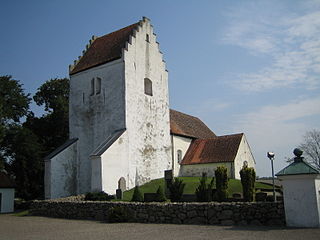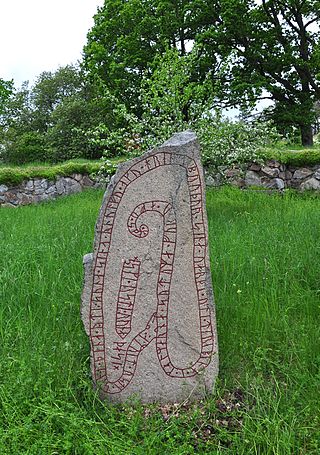The Funbo runestones constitute a group of four runestones originally from Funbo in the province of Uppland, Sweden, which were raised by members of the same family during the eleventh century.

The Dynna Stone is a runestone from the late Viking Age that was originally located in Gran, Norway.

The Skarpåker Stone, designated by Rundata as Sö 154, is a Viking Age memorial runestone that originally was located in Skarpåker, Nyköping, Sörmland, Sweden. It dates to the early eleventh century.

The Snottsta and Vreta stones are individual runestones known as U 329, U 330, U 331 and U 332. They are found on the homesteads of Snottsta and Vreta, and they tell in Old Norse with the younger futhark about the family story of Gerlög and Inga in 11th century Uppland, Sweden, together with the Hillersjö stone and the runestone U 20/21.

The Jarlabanke Runestones is the name of about 20 runestones written in Old Norse with the Younger Futhark rune script in the 11th century, in Uppland, Sweden.
The Ingvar runestones is the name of around 26 Varangian Runestones that were raised in commemoration of those who died in the Swedish Viking expedition to the Caspian Sea of Ingvar the Far-Travelled.

The Granby Runestone, designated as U 337 under the Rundata catalog, is one of the longest Viking Age runic inscriptions located in Uppland, Sweden.
The Klepp I Runestone, listed as N 225 in the Rundata catalog, is one of two runestones from Klepp in Rogaland, Norway. It is among the few Viking Age runestones that was raised as a memorial to a woman.

The Orkesta Runestones are a set of 11th-century runestones engraved in Old Norse with the Younger Futhark alphabet that are located at the church of Orkesta, northeast of Stockholm in Sweden.

The Hagby Runestones are four runestones that are raised on the courtyard of the farm Hagby in Uppland, Sweden. They are inscribed in Old Norse using the Younger Futhark and they date to the 11th century. Three of the runestones are raised in memory of Varangians who died somewhere in the East, probably in Kievan Rus'.
The Greece runestones are about 30 runestones containing information related to voyages made by Norsemen to the Byzantine Empire. They were made during the Viking Age until about 1100 and were engraved in the Old Norse language with Scandinavian runes. All the stones have been found in modern-day Sweden, the majority in Uppland and Södermanland. Most were inscribed in memory of members of the Varangian Guard who never returned home, but a few inscriptions mention men who returned with wealth, and a boulder in Ed was engraved on the orders of a former officer of the Guard.
The England runestones are a group of about 30 runestones in Scandinavia which refer to Viking Age voyages to England. They constitute one of the largest groups of runestones that mention voyages to other countries, and they are comparable in number only to the approximately 30 Greece Runestones and the 26 Ingvar Runestones, of which the latter refer to a Viking expedition to the Caspian Sea region. They were engraved in Old Norse with the Younger Futhark.

The Varangian Runestones are runestones in Scandinavia that mention voyages to the East or the Eastern route, or to more specific eastern locations such as Garðaríki in Eastern Europe.
The Viking runestones are runestones that mention Scandinavians who participated in Viking expeditions. This article treats the runestone that refer to people who took part in voyages abroad, in western Europe, and stones that mention men who were Viking warriors and/or died while travelling in the West. However, it is likely that all of them do not mention men who took part in pillaging. The inscriptions were all engraved in Old Norse with the Younger Futhark. The runestones are unevenly distributed in Scandinavia: Denmark has 250 runestones, Norway has 50 while Iceland has none. Sweden has as many as between 1,700 and 2,500 depending on definition. The Swedish district of Uppland has the highest concentration with as many as 1,196 inscriptions in stone, whereas Södermanland is second with 391.

The Gällsta Runestones from the 11th century commemorate four generations of the same family in Viking Age Sweden. There are three runestones and a raised stone which is only inscribed with a cross. The runestones are located at the northern outskirts of Stockholm, just northwest of the lake Vallentunasjön, around which is found the world's greatest concentration of runestones. All the Gällsta Runestones are attributed to Öpir, the most productive of all the old runemasters.

Uppland Runic Inscription 308 or U 308 is the Rundata catalog designation for a memorial runestone that is located in Ekeby, Stockholm County, Sweden, which was in the historic province of Uppland. While the tradition of carving inscriptions into boulders began in the 4th century and lasted into the 12th century, most runestones date from the late Viking Age.

The Skårby Runestones are two Viking Age memorial runestones originally located in Skårby, which is about ten kilometers northwest of Ystad, Scania, Sweden.

The Stangeland stone or N 239 is a Viking Age runestone engraved in Old Norse with the Younger Futhark runic alphabet in Stangeland, Norway, and the style of the runestone is the runestone style RAK. It was found on Stangeland Farm, where it has been moved several times and for many years was used as a bridge over a river.

The Södermanland Runic Inscription 333 is a Viking Age runestone engraved in Old Norse with the Younger Futhark runic alphabet. It is located at the abandoned Ärja Church in Strängnäs Municipality. The style of the runestone is a categorized as Fp.
The Runestone of Galteland is a runestone from the beginning of the 11th century CE, coming from Evje in the commune of Evje og Hornnes in southern Norway. Its name refers to the Galteland garden, where it was located for some time. It commemorates the expedition of the Danish king Canute the Great to England in 1015–16. It also contains one of the first references to the Christian faith in Norway.



































